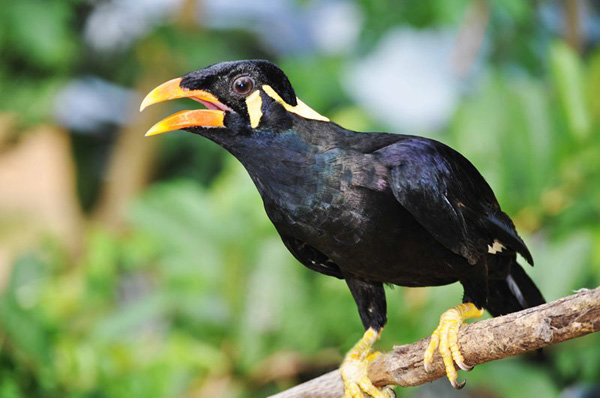- The indigenous Rejang are rediscovering multicropping after years spent focusing on coffee monoculture.
- The Rejang generally abandoned polyculture after the national government established a national park on their lands.
- Multicropping helps them make money year-round instead of just when it’s time for the coffee harvest.
TIK SIRONG, Indonesia — It is often said in this archipelago country that the best solutions come through consensus. The phrase typically refers to people. But sometimes a compromise is made across time.
Take for instance the Rejang people, who live in 65 villages abutting Sumatra’s stunning Kerinci Seblat National Park.
Measuring in at twice the size of Bali, Kerinci Seblat is a dramatic park dotted with caves, peaks and the largest crater lake in Southeast Asia. One of the last homes of the endangered Sumatran tiger (Panthera tigris sumatrae), the park also boasts 370 bird species.
But the park was established in 1999 without consulting the peoples already extant here. With clan lands falling in the area the national government cordoned off for conservation, the Rejang “were labeled ‘illegals’ and ‘encroachers’,” said Erwin Basrin, director of the Akar Foundation, a local community development group. Along with modernization and market forces, “This changed their view of how forests and their gardens should be managed.”
The treatement of the Rejang is but one example of an ugly history in the field of conservation of marginalizing indigenous peoples. But today in Sumatra, years after Kerinci Seblat absorbed their clan lands, the Rejang are rediscovering their heritage by relearning the polycultural agriculture practiced by their ancestors.
Retro-gardening
In the tiny village of Tik Sirong, former headman Busroni was the first to convert his coffee grove into a polyculture garden — in which multiple crops are grown in the same space — interspersing the coffee bushes with kabau and jengkol bean trees.
The species are easy to maintain. Harvest season for the beans is December through January, a particularly tough time of year for monocrop coffee farmers. With the monoculture gardens, the harvest comes once a year, between May and August. And the money from that is supposed to last all year. A failed crop might mean a family must turn to pawning goods or doing contract labor.
But kabau and jengkol beans don’t spoil, which means they can be sold throughout the year. Jengkol, used in curries and chili sauce, is prized by Indonesians, sometimes fetching a better price in the market than beef or chicken.

Busroni planted the bean trees in 2005. “Initially, the villagers rejected [Busroni’s] garden system,” said Sahrul Arufi, the new village chief. “But then he made his first harvest in 2010 and news of his success spread.”
Today, half of Tik Sirong’s 600 families also plant the trees in their coffee groves, 10 to 15 plants each. Some also plant petai beans, durian and bamboo.
“In the past, bamboo was ubiquitous to the Rejang garden,” Busroni said. “We planted bamboo at the garden edge or at steep sections. Bamboo shores up soil that might otherwise erode,” making floods more likely. In 1995, flash floods killed nine people and destroyed houses in Tik Sirong.
The sturdy plant doubles as a versatile building material for houses, garden fences and household utensils. What’s left is sold in the market.
“Only if we have other, valuable harvest plants in the garden can we get returns, otherwise we have to open new gardens,” Busroni said. Near Kerinci Seblat, the agricultural soil must be improved every seven years. Before the reintroduction of polyculture gardens, farmers abandoned lots once the soil fertility went down, choosing instead to clear forest for new gardens.

Aligned with science
Yansen, head of the Agriculture Department at the University of Bengkulu, is a fan of Tik Sirong’s polyculture efforts. “It is wonderful this technique and local wisdom are being used again,” he said. “Polyculture truly rebuilds forests. It is in line with science.”
Ecological studies have shown that polyculture groves stabilize microclimates and aid soil structure and fertility. Mixed planting also reduces runoff because it reduces soil exposure. This in turn regulates groundwater levels.
Yansen thinks polyculture groves are a positive step because coffee actually does better in a mixed planting scenario as opposed to monoculture plots. Coffee needs protective plants to reach its maximum productivity. Jengkol, kabau, petai, durian, lamtoro, dadap, and other plants can play that protective role.
The bean trees jengkol, kabau and petai are all members of the Leguminosae family. That means they can store nitrogen from the air in their roots, fertilizing the soil. “All plants need nitrogen though not all are able to absorb it,” Yansen said.

Conflict resolution
In Basrin’s view, the government can aid the Rejang in two main ways: first, by recognizing their rights to the lands they have customarily managed — in line with a broader push for indigenous rights in Indonesia — and second, by allowing clan lands to be co-managed by the national park and the Rejang themselves.
To help bring this about, the Akar Foundation has facilitated the mapping of customary lands in nine of the 65 Rejang villages and submitted the maps to a district legislature to be incorporated into government maps of the area.
Basrin hopes that within the next year the local government will formally recognize the customary lands. Four other villages are currently in negotiation with the national park.
Banner image: A Sumatran tiger. Photo by Rhett A. Butler for Mongabay.
This story was reported by Mongabay’s Indonesia team and was first published on our Indonesian site on Oct. 5, 2016.
